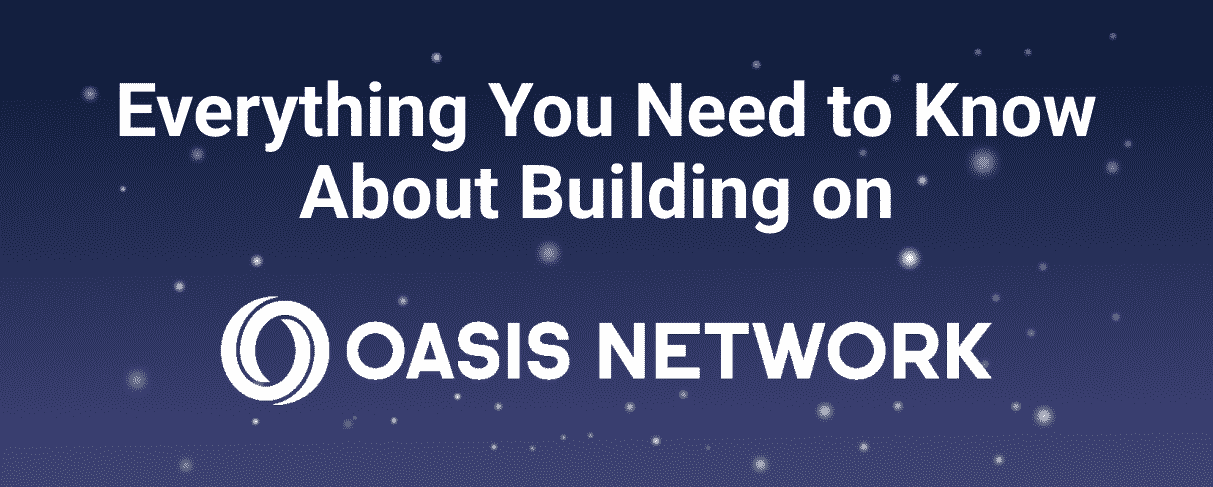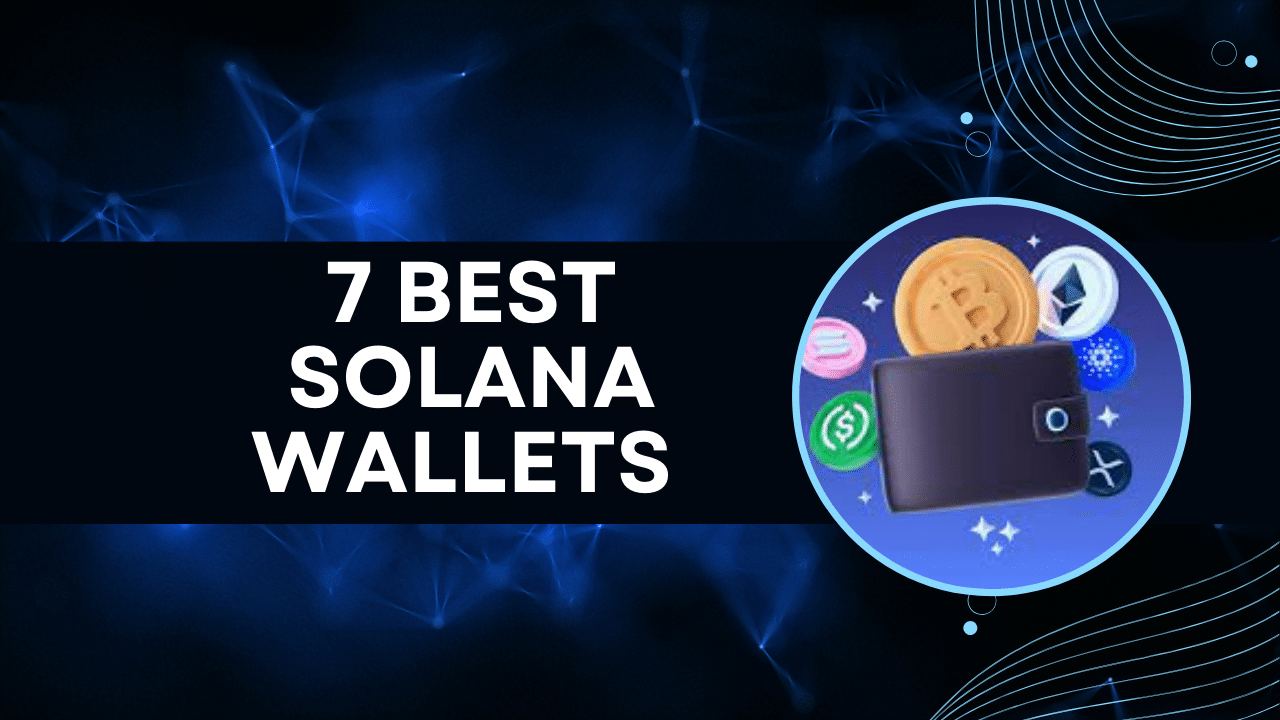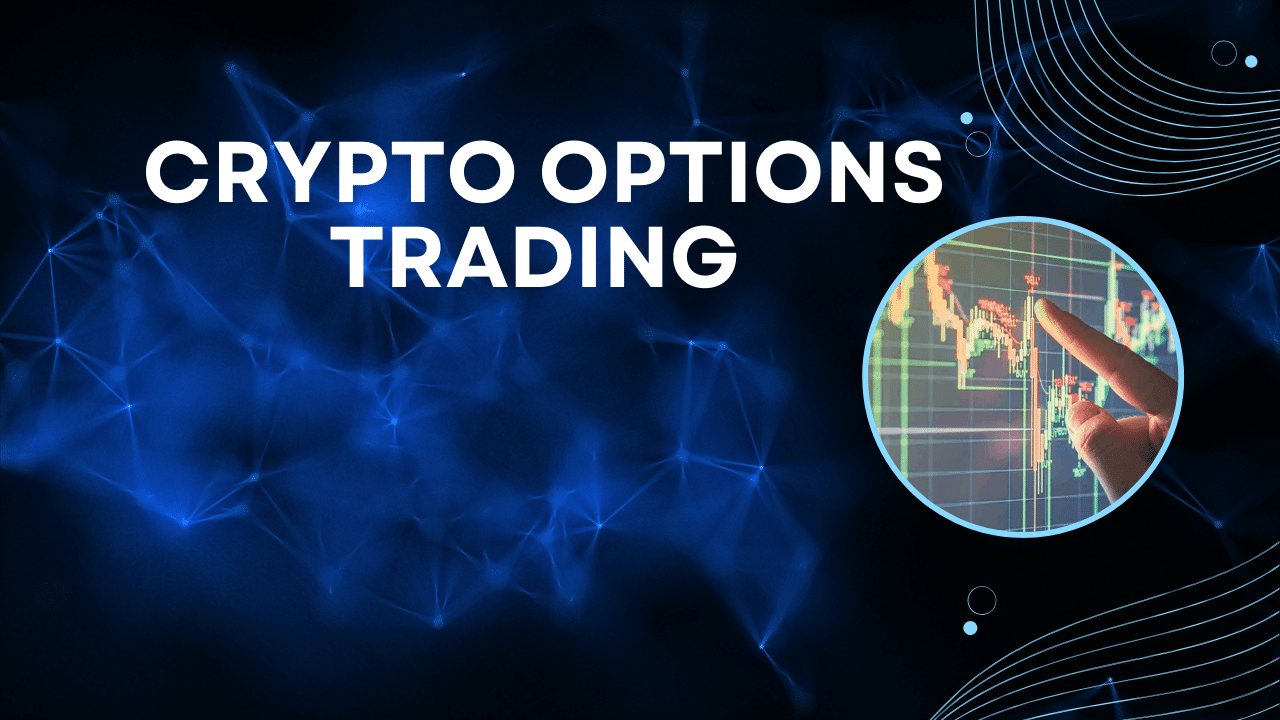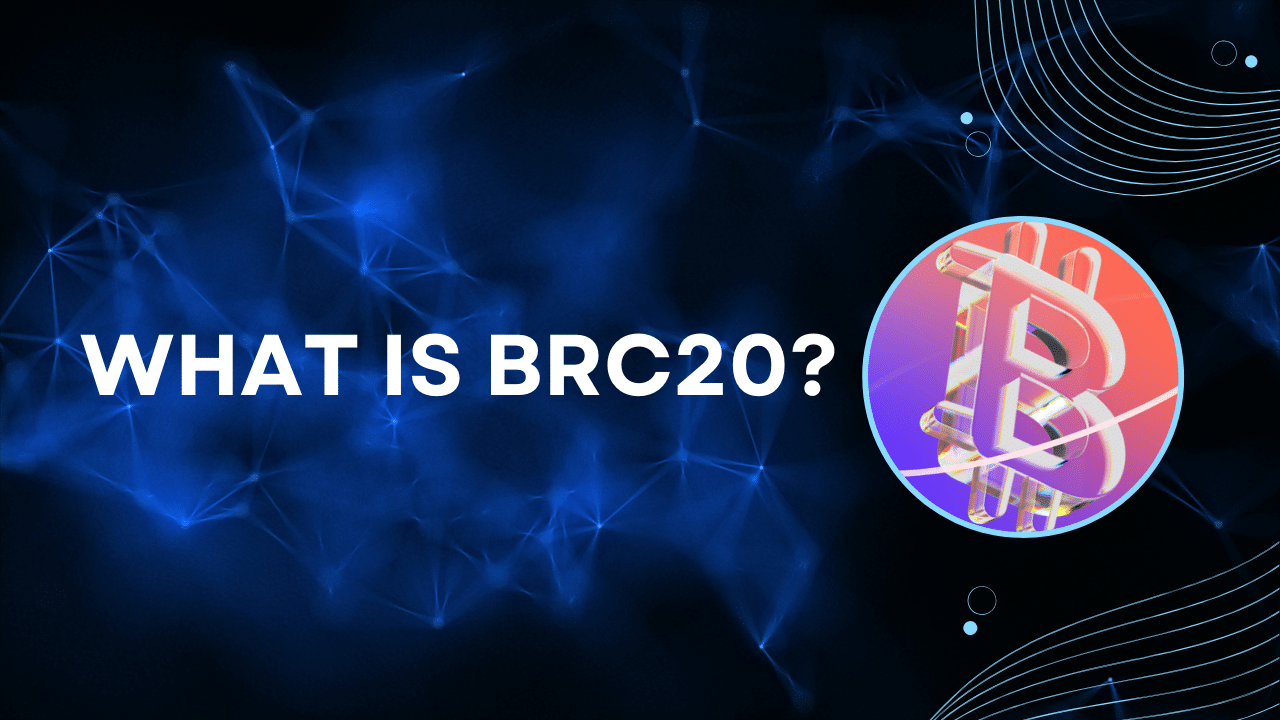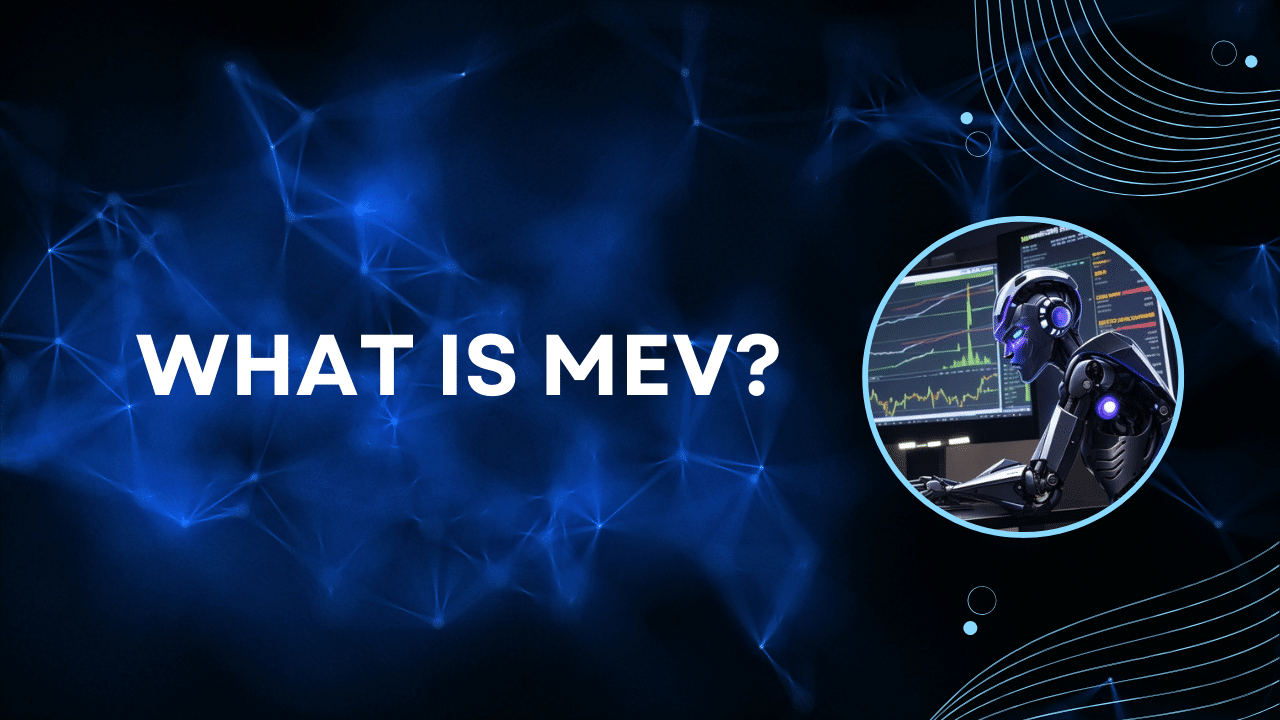Contents
Everything You Need to Know About Building on Oasis Network
If you are considering building on top of the Oasis Network, keep in mind that you can participate inthe Oasis Bloom Hackathon.
The DeFi market is still in its infancy. While it is true that there are trillions of dollars in existing financial markets ready to enter the space, DeFi is limited in terms of the privacy and security it can offer and has high fees on top of that. The result of this is an overloaded and expensive system that’s impossible to truly scale on a global level.
Data within the blockchain is also transparent and open to anyone. While these blockchain networks are a compelling option when you want the information to be public, things can get less compelling when dealing with sensitive information, along the lines of health records or even credit data.
In fact, anyone can track anything on the blockchain that’s typically not available in traditional finance, such as wallet activity, transaction levels, speed, and other information. This leads us to the conclusion that privacy is a critical aspect of DeFi that needs to be dealt with if it aims to capture more of the traditional market.
There is a new Layer-1 protocol on the scene, which is specifically tailored towards powering DeFi, and it is one of the fastest-growing protocols as of yet. This Layer-1 protocol is known as the Oasis Protocol, and today, we will be taking an in-depth look at everything it has to offer and going over some of its recent developments.
If you are a developer that wants to build decentralized applications (DApps) on the Oasis Network, then this guide will give you an in-depth look at just about everything you can expect.
The Oasis Bloom Hackathon will allow you to be a part of the next generation of dApps for Web3 and beyond, and will take place from March 10, 2022 up until May 2, 2022, where you can expect $200,000 in prizes.
Contents
What is Oasis Network & Why Build on Oasis?

It is due to the aforementioned issues that the Oasis Network was created. The Oasis network is privacy enabled & scalable Layer-1 blockchain aimed at specifically expanding Decentralized Finance (DeFi) far beyond early adopters into the mass market.
The main way it does this is by introducing privacy-preserving features and confidential computation, all of which allow any sensitive data to exist on-chain. This is the main way through which it aims to essentially open the flood-gates to new use-cases, such as private lending or even under-collateralized loans.
The protocol promises instant finality, much lower gas fees when compared to Ethereum (99% lower), a high level of throughput, protection against MEV, and, most importantly, privacy protection.
The Oasis Network achieves a high level of scalability due to its highly modular design, separating the consensus and computation into two parallel layers. As a result of this, the network is the first Layer-1 to natively support rollups which enables the network to manage many different complex transactions at scale.
Oasis provides similar benefits as a protocol would get through utilizing sharding, but unlike sharding, which has a lot of complexity associated with it, Oasis offers implementation, which is much simpler and a lot more efficient.
There is no going around the fact that traditional finance is essentially a black box, and if we truly have an intention of unlocking DeFi to a much broader market, there are transactions that will need to remain private, and this is the fundamental goal behind the Oasis Protocol.
Through the introduction of Cipher’s private smart contracts and confidential computations to the blockchain network, we can see benefits such as private and under-collateralized lending, decentralized private exchanges without an MEV, private stablecoins which protect the identity, balance, and transactions of the users, and private settlements which protect the sender, receiver as well as the transaction amount.
Alongside all of this, the Oasis Network features built-in functions that enable support for what is known as confidential smart contracts, and since the data is never locked to a node operator or an application developer, any sensitive information is safely used by blockchain applications across the entirety of the Oasis Network.
Hopefully, now you have a heightened level of understanding of what the Oasis Network actually is. Now we will be going over its history and major milestones, so you can have a heightened perspective as to exactly why you might want to build DApps on the Oasis Protocol.
History of the Network and The Major Milestones
The project originally started in 2018 However, the Mainnet Beta for the Oasis Network went live for the first time on October 1, 2020, with the Final Mainnet going live on November 18, 2020. At this point in time, the Oasis network saw numerous developments, many of which occurred throughout 2021.
First, Oasis Network saw the completion of a network upgrade through on-chain governance, which had over 85% in terms of participation.


In 2021, we also saw the launch of the $200 million Oasis ecosystem fund, which was dedicated to supporting new as well as existing projects that aimed to build on top of Oasis. This fund was intended to help power the future of Oasis DeFi, NFT, metaverse, and data tokenization DApps, and was supported by many industry backers. Note that this fund, over time, grew to over $200 million.
This was later built on with Fortune 100 partnerships. In other words, throughout 2021, Oasis announced over 20 new partnerships added to their already well-established partner ecosystem. Some of these companies included Genetica, Cryptosafe Alliance by Binance, and BMW..
Oasis has partnerships with Genetica, which is Asia’s fastest-growing genome sequencing company, as well as MetaMirror, whose MBuddy is the first-ever Web 3.0 identity service specifically built for the metaverse. Both of these partners are essentially leveraging the power of Parcel to offer better privacy and control across their customer’s most sensitive data.
Another major milestone that Oasis saw throughout 2021 was the launch of DeFi on Oasis.
NFTs also arrived within the Oasis network, as Oasis introduced the Oasis AI ROSE NFT Collection contest. This was the first NFT collection which was supported by MetaMirror and minted on the Oasis platform, which consisted of 999 AI-generated images of roses, tokenized into NFTs, and offered for free across members that made it onto the whitelist.
In terms of the growth of the Oasis community, Oasis saw an active community across 24 countries with more than 160,000 community members and over 310 ambassadors throughout 2021.
Recent Growth, Roadmap, and Partnerships
The growth of DeFi on Oasis can be marked when, on January 11 of 2022, we saw the launch of the Wormhole Bridge and YuzuSwap. This marked a massive development within the Oasis network as well as the community.
Specifically, YuzuSwap is a DEX allows users to participate within liquidity pools, where they can swap, trade, and earn rewards with high APY, while the Wormhole bridge enabled the connection of Oasis with almost $1 billion in total value locked (TVL) across Avalanche, the Binance Smart Chain (BSC) Terra, Ethereum, Polygon and Solana. We will cover a lot more about YuzuSwap further along with this guide.
As for the roadmap planned for 2022, Oasis announced that they intend to add more Decentralized Finance (DeFi) apps to Emerald,the EVM compatible ParaTime.
Additionally, they also announced the plans towards the launch of the WebAssembly smart contracts module on the Cipher Mainnet with confidential DeFi apps.
Furthermore, there will be developments on the general availability of data tokenization in Parcel ParaTime and a network upgrade proposal that will increase the performance of both the consensus layer and ParaTimes.
On top of that, there will be participating in several events, and there is even a hackathon launch planned alongside new programs for any developers.
Cipher ParaTime and Privacy-Preserving Smart Contracts
On June 30, 2021, Oasis introduced the Cipher ParaTime. This is their smart contract environment that ultimately came to the Oasis Network.
Today, there are two ParaTimes that are available within the network.
The first is the Parcel ParaTime, a custom-designed ParaTime specifically used to support the Oasis Lab’s Parcel SDK. Parcel is essentially a simple API interface that allows developers to store data access any confidential compute technology and mint data-backed NFTs.
The second is the Oasis-Eth ParaTime, which is essentially an EVM compatible ParaTime specifically designed as a means of supporting DApps ported from Ethereum to the Oasis Network. The ParaTime has better performance and gas fees which are 99% cheaper than Ethereum.
However, the interesting addition here was Cipher, the powerful ParaTime that came to the Oasis Network. It enabled fully decentralized node operators to operate the ParaTime, native support for Oasis ROSE tokens to pay for gas fees and for easy integration within DeFi DApps, as well as a bridge to the Ethereum network for easy swaps alongside a WASM-based smart contract environment that enabled support for Confidential smart contracts.
New Web3 Use cases
Oasis Network has a high safety factor, strong performance, is extremely modular, and as such, enables great scalability. However, it also features a high degree of customization, as developers can customize ParaTime to adapt to multi-functional application scenarios.
As data becomes a lot more valuable, Web2 has raised many questions around data ownership, value, and extractions, which paved the way for a lot of risks in terms of usability issues with using data at scale. Value is not evenly distributed. Web3, on the other hand, empowers individuals and end-users and gives them the right to how they want their data to be consumed.
Due to the fact that Oasis puts an emphasis on data privacy and security, it can essentially pave the way to Web3 and bring back control of the data to the end-users.
Data Tokenization vision
Parcel enables private data marketplaces data governance, which can insulate a company from risks around directly holding user data, analytics cleanrooms, and data tokenization.
In terms of the data tokenization vision behind Oasis, the data is uploaded to Parcel. The data owner then transfers ownership of the data to the tokenization service and then receives a minting token.
The data owner uses the minting token to issue several tranches of tokens, where each of them has different access rights. Other Parcel users then purchase the data token from a marketplace and use the token to run jobs on the underlying data asset.
The Oasis DEFI Ecosystem Oasis Network has a robust and growing DEFI ecosystem and recently exceeded $200 million in TVL. Some of the key DEFI Dapps are:
YuzuSwap

YuzuSwap is a decentralized exchange built on the Oasis Emerald ParaTime, which includes incentives, including liquidity and trade mining. It follows a non-custodial, peer-to-peer (P2P), automated market maker (AMM) model to provide a safe, quick, and low-cost tool that enables users to discover and swap tokens within the Oasis ecosystem. This is a platform that’s fully open to developers as well as members of the Yuzu DAO.
This essentially means that it leverages the low fees and the huge throughput of up to 1,000 Transactions Per Second (TPS) of Emerald, which is the EVM compatible ParaTime. The goal of YuzuSwap is essentially for it to become a cornerstone DeFi application that is built on Oasis and can be composable open, with safety and fairness behind it.
YuzuSwap enables the following:
- Trading – users can trade in incentivized pairs to earn a balance of Trading Pool Share Token (TPST) that will continue accruing with every block until it is withdrawn.
- Providing Liquidity – Users can support the network by providing liquidity, where in turn, for doing so, they earn LP tokens.
- Yields – The yields will vary based on the proportion of the pool a liquidity provider has.
Additionally, YuzuSwap features a fair launch system that slowly and methodically releases the same number of tokens with every new block, which occurs once every 6 seconds. The total token supply is capped at 500 million, where every block ends up releasing 50 YUZU tokens.
Out of those 50 tokens, 37.5 will go to the liquidity and trade mining pool, five will go to the team, 5 to the foundation, and 2.5 to early backers. Furthermore, 80% of the transaction fees which are collected will go to a Smart Contract, where it actively works towards supporting and contributing to a stable token price.
Fountain

On February 28, we saw the launch of the Fountain protocol within the Oasis Network that initially featured a Liquidity Mining Program.
Fountain protocol is essentially the first cross-chain lending platform that the Oasis Network fully powers, and this protocol was specifically developed as a means of enabling users to experience high capital efficiency within a one-stop management process for DeFi assets.
The main reason it was built on top of the Oasis Network is the efficiency and low costs associated with the operation there, and it even establishes a multi-revenue protocol with a fund pool.
When we look at the liquidity mining program, with the launch of Fountain protocol, we also saw the launch of a Liquidity Mining Program for suppliers and borrowers that participate within the Lending Pool on oasis Network.
This program promises a total of 4,000,000,000 FTP which is 40% of the total supply in tokens throughout the span of 4 years, to be allocated across asset markets as liquidity incentives.
GemKeeper

On February 22, the Oasis Network introduced GemKeeper, which is a security audited DEX that runs on top of the network.
This DEX was built from the ground up to support standard AMM features, which allow users to swap tokens, enter within liquidity pools and even create new liquidity pools within a 100% permissionless way.
It also enables users to farm GemKeeper’s governance token, which is known as BLING, through the process of staking their GemKeeper Liquidity Pool (GLP) tokens within what is known as the “Gem Mine.”
GemKeeper.finance is essentially a community-focused Automated Market Maker (AMM) and Decentralized Finance (DeFi) platform that is built on top of the Oasis’ Emerald Paratime, and the vision here is to build an all-in-one shop that offers a variety of different DeFi applications which will meet any user’s DeFi needs within a simple way.
Oasis launched two official Oasis Wallets both Web and a browser extension that allow anyone quick and easy access to their ROSE whenever they need it. Finally, two bridges are live, Wormhole and cBridge, allowing cross-chain interoperability and enabling Oasis to power more DeFi applications as a result.
Key Growth Metrics
According to data from DeFi Lama, the Oasis network has grown and currently has $210.88m million in Total Value Locked (USD) as of March 21, 2022, where it has grown in the last 24 hours by 4.72%.
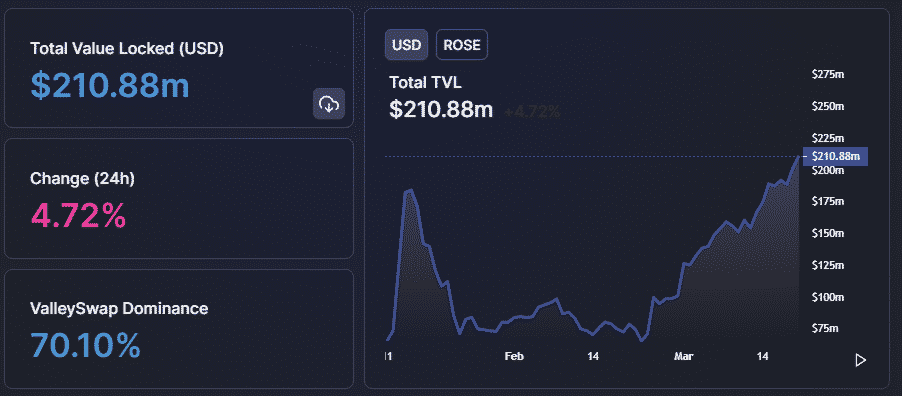
In terms of its overall ecosystem, the leader of the DApp pact is ValleySwap (VS), with YuzuSwap (YUZU) and Fountain Protocol (FTP) being second and third and GemKeeper in fourth place.
Network Architecture & Paratimes What Paratimes Are Available to Build Upon
When we go over the Oasis Network’s architecture, it is a Layer 1, Proof-of-Stake (PoS) decentralized network that has two main components.
- The Consensus layer – this is a scalable, high-throughput, and secure PoS consensus that is run by a network of validator nodes that are fully decentralized.
- The ParaTime layer – this is essentially a layer that hosts many parallel runtimes, which are called ParaTimes. Each of them represents a replicated compute environment with a shared state.

The main difference between a Parachain and ParaTime is that a ParaTime does not need to do consensus itself, which makes it a lot simpler to develop and more integrated within the network. ParaTimes essentially take care of compute, and discrepancy detection is used as a means of ensuring the correctness as well as the integrity of execution. This makes ParaTimes a lot more efficient than Parachains.
There are multiple Paratimes on top of which developers can start building, and these include:
- Cipher ParaTime — this led to the launch of the all-in-one privacy-enabled ParaTime, which is one of the vital building blocks intended to truly unlock the true potential behind Decentralized Finance (DeFi).
- Oasis Emerald — this is a fully decentralized ParaTime with full EVM compatibility, which allows for easy integration with any EVM-based decentralized applications (DApps), including DeFi, NFT, Metaverse, and Crypto gaming, alongside a cross-chain bridge that can enable cross-chain interoperability.
- Parcel SDK — this is a privacy-first data governance SDK that is fully equipped with powerful privacy tools that make it an easy-to-use solution.
Growth of usage of Emerald ParaTime
On November 18, 2021, the Oasis Foundation introduced Emerald. This is an EVM Compatible ParaTime, which is a Smart Contract environment offering full EVM compatibility, which went live on the Oasis Network mainnet.
It initially had 30 node operators, and expanded to 60+ in March 2022, and aimed to bring a host of new features as well as capabilities within the Oasis Network.
The Oasis Network is fast due to its fundamental design, notably the fact that consensus operators are responsible for maintaining an immutable ledger, which is separated from computing operations.
This allows many compute environments that exist in parallel, called ParaTimes. Each writes their own transactions within the Consensus Layer, and anyone can build a ParaTime that can be customized to fit each developer’s unique requirements.
The first use-case for Oasis Emerald was YuzuSwap, which is the aforementioned Decentralized Exchange (DEX).
However, on October 25, 2021, we saw the launch of Cipher ParaTime on the mainnet.
In other words, at this point in time, the Oasis Foundation announced the Cipher ParaTIme launch onto the Oasis Mainnet.
Its core features include the fact that it is fully decentralized with node operators, which are distributed across the world, that Oasis ROSE tokens will be the native tokens used in the ParaTime for gas fees, support for WebAssembly smart contracts, and support for confidential computing.
Useful Resources & Documentation on How to Get Started to Build a DApp on Oasis
There are many resources currently available to developers who want to engage in the process of building DApps on top of the Oasis Protocol.
Start by going over the following documentation:
Then there are also “How-to” video tutorials live in the Official Oasis Network YouTube channel, where you can learn things such as:
You can also visit Oasis’s official guide, where you can learn how to transfer ETH/ERC20 to Emerald ParaTime, which will allow you to bring your assets from Ethereum, BSC, Polygon or Avalanche to Emerald ParaTime through the usage of the Wormhole token bridge.
After that, you can move on to the documentation regarding the process of writing DApps on Emerald (EVM compatible ParaTime) on both the Testnet and the Mainnet.
For using Testnets with TEST tokens, please use our official Oasis Network Testnet Faucet.
If you need some additional information or you want to ask some technical questions, we have a great and very strong community on Slack.
Interested in running your own node?
Please review prerequisites first, then you can choose what kind of node you would like to run. Running your own node can give you a more in-depth view and insights that are not visible otherwise. It also helps Oasis network to be more robust and reliable.
Programs to Support Developers
In terms of programs available to support developers, there is the $200 million Oasis Ecosystem fund, which is supported by top industry backers and dedicated towards helping founders build on Oasis.

There is also the $200,000 oasis Bloom hackathon, which comes with support from Jump Crypto, Newman Capital, Neo Global Capital and Hashed, and this online hackathon will take place on the Devpost platform from March 10, 2022 up until May 2, 2022.
Furthermore, DappRadar and Oasis Network launched a $500,000 Accelerator Program, where this partnership will enable 10 teams to access up to $50,000 in funding each, alongside gaining resources and technical knowledge that they might need in order to kick-start their projects.
Note that there is also the Oasis Grants Program. This is known as the ROSE Bloom Grants Program, which will let teams kickstart the development of their projects in a range of key focus areas, and support DeFi, NFT, P2E Gaming, Metaverse, Data DAO, data tokenization and privacy dApss. Here, each proposal can receive up to$50,000 USD in ROSE tokens.,
Moving Forward with Developments on the Oasis Protocol
Ultimately, the Oasis Protocol is a Layer-1 chain that has seen exponential growth in the DeFi sphere ever since its launch. Emerald is an EVM ParaTime and not the core functionality within the Oasis network. However, it has still managed to pull off a great level of growth in terms of transactions, wallet addresses, and project tokens launching.
Emerald has 0 transaction fees at the time of writing, and even when this changes, they will be much less when compared to competing blockchains.
It offers instant finality, and blocks are confirmed within seconds, making it an ideal EVM for Ethereum developers. Oasis has also gathered a lot of love from its community due to the promise of Privacy-Preserving Smart Contracts on Cipher ParaTime, all of which are due to be released by the end of Q2, 2022.
Parcel ParaTime, which is Oasis’s confidential data storage and governance ParaTime, already works with many enterprise partners. All of this will contribute to the overall growth of the Oasis Protocol, and it can definitely be seen as the future of DeFi.
Now that you know a bit more about the Oasis Protocol make sure that you go over as many development resources as possible and discover if this is the right protocol on top of which you want to build your DApps, and if that’s the case, utilize as many of the advantages found here as possible, and you will see your DApp shine in no time.
